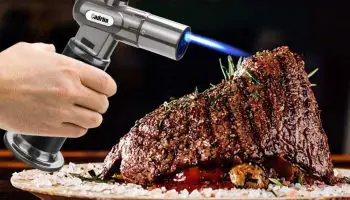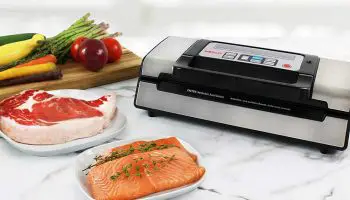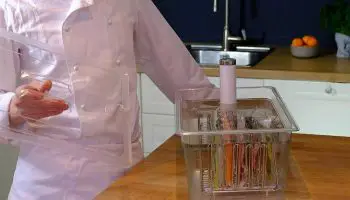Sous vide is a convenient method of slow cooking various foods without losing their original color, texture, flavor, and nutrients. The technique involves the use of sous vide equipment that is, luckily, easy to maintain.
The equipment will include the sous vide circulator, an oven or large pot for the water bath, Ziploc or sous vide bags, a vacuum sealer, and bag clips to keep the bags attached to the container and submerged in water.
Though they are not hard to maintain, you will need to clean the equipment regularly to avoid the buildup of bacteria or scales. Let’s look at some of the best ways to keep your equipment clean and in top condition.
Follow the equipment user manual
Almost all equipment comes with a user manual on how to use the equipment properly and steps you can take to disassemble the equipment and put it back if need be.
Your sous vide equipment will have a user manual with instructions on cleaning it because manufacturers know that the user has to clean the equipment often.
Follow the user manual’s guidelines on how to clean your machine, whether it’s the immersion circulator or sous vide water oven. Do not attempt to do anything against the manual as it could ruin the appliance or lead to injuries.
Cleaning the equipment
Before cleaning any equipment, ensure that you unplug it first. For regular cleaning, use a clean and damp cloth to wipe everything down, either the immersion circulator or sous vide machine.
After wiping, let it dry before using it again. When cleaning the immersion circulator, avoid immersing the electronic head in the water as this could ruin it.
For food particles that may have gotten lodged inside, follow the user manual instructions or the manufacturer’s website instructions to disassemble the head. Wipe it gently with a damp cloth and toothbrush for unreachable parts, then carefully reassemble it.
Scale buildup
A lot of tap water contains hard water, and the minerals in the water lead to scale buildup over time.
You may notice that your sous vide machine has developed scales due to frequent water use, which leaves mineral deposits behind. The buildup usually depends on how hard your water is and how often you use the machine.
Buildup may be white, black, brown, or green, and it will form around the heating unit. The buildup may affect your machine’s functioning, like how it heats up, so you should be on the lookout for these deposits.
For scale buildup, an easy solution is vinegar. The acidic nature of vinegar magically dissolves the scales while still being gentle enough not to corrode your machine.
To clean, mix equal parts of water and distilled white vinegar in a pot. Place the immersion circulator and set it to temperatures of 140°F (60°C).
Let the circulator run for one hour and check if the scales have cleared up. Drain the water and replace it with clean water.
Let your circulator run in the clean water for a few minutes to rinse, then take it out and dry it with a clean, soft cloth.
For the water oven, use the same vinegar solution. Remember not to pour water on the whole device but only on the water bath part.
Let it sit for an hour, then drain the water. Rinse with clean water and allow the oven to dry.
CLR cleaning
Sometimes, the scale deposits may not clear up even after a thorough vinegar bath. On such occurrences, you can apply a CLR bath.
CLR is a Calcium Lime Rust remover that is popular for removing stubborn and severe calcium or lime deposits and rust from surfaces. It’s quite strong, and you should read its instructions carefully.
Though it’s a household cleaning product, you should only go for it as a last resort because your equipment is for cooking, and you don’t want to risk your health by ingesting any of it.
For the CLR solution, use 10% CLR and water. Pour it into a pot and put the immersion circulator inside. Turn it on to a temperature of 140°F (60°C) and let it run for an hour.
After one hour, take out the circulator and drain the CLR solution. Wash the pot thoroughly and fill it with fresh, clean water.
Place the circulator inside again and let it run for several minutes. Repeat the rinsing process until you are sure that all the CLR has washed off.
Take out the circulator and wipe it dry with a clean, soft cloth. You can also let it air-dry then store it.
For the water oven, run the CLR solution in the water bath area and let it sit for one hour. Then drain the water and rinse thoroughly until all the CLR has washed off.
Leave it to dry completely.
Cleaning Vacuum Sealers
If you have invested in a vacuum sealer, it will require cleaning too. The vacuum sealer tray may have some food particles or liquids that drop on it during sealing.
Begin by turning off the machine and unplugging it. Then wipe it with a damp cloth.
Take out the tray from the vacuum sealer and drain it. Place it in the dishwasher if it is dishwasher-friendly. If not, wash it yourself with mild soap and a soft cloth before giving it a rinse.
Let it dry and place it back in the vacuum sealer. Allowing the parts to dry completely prevents accidental electrical shocks.
For a vacuum chamber machine, wipe it with a damp cloth and put the external vacuum hose in hot soapy water to clean. Give it a rinse and allow it to dry.
How Often Should You Clean Your Sous Vide Equipment
First, do not let your water bath sit for an extended period. Some people advise draining the water after every use, but it’s all a personal preference.
If the water bath is still clean and you are okay with having another round of cooking, that’s fine. As long as it’s not having a funny smell or change in color, go ahead and reuse the water.
You can clean your equipment as regularly as you deem fit. It is not necessary to do a thorough cleaning every time you use sous vide.
But if there are food leaks in the water bath, you will need to drain all the water and clean it up.
What to Do if a Sous Vide Bag Leaks
Sometimes you may have the rare leaks of your sous vide bag. It can be a minor leak or a full-on bag rupture that leaves your water bath looking like a sorry mess.
In case this happens, drain the water bath first. Then go ahead with a vinegar-water solution clean.
Clean and rinse the immersion circulator, and the sous vide oven. Afterward, refill your water bath with clean, fresh water.
How to clean sous vide bags
Most sous vide bags are reusable, and that’s a good thing because you will not need to purchase a new bag each time you want to prepare food. You can wash some bags in the dishwasher, and all you will be required to do is drop them in and let them get cleaned up.
If the bags are not dishwasher-safe or you need to handwash them, it’s also easy.
Here’s how to do it:
What you will need
- Small brush to scrub
- Distilled white vinegar
- Baking soda
- Lemon juice
- Water
Instructions
First, give the bag a rinse with hot water. Fill it almost halfway with water, zip it up well, and shake the bag.
The swishing of the water will help dislodge food particles. If there are any left after doing this, use the brush to scrub them off.
Mix equal amounts of vinegar, baking soda, and lemon juice. Use your brush to apply the paste around the inside parts of the bag.
Leave the bag to sit for about half an hour. Then rinse thoroughly with warm water and let the sous vide bag dry before using it again.
Tips
Do not turn sous vide bags inside out as this may make the seal stop working correctly, making it not fit for reuse.
To avoid ugly stains, opt for colored bags that will not be discolored by foods like curry or tomato paste.
In case of mold in your bag, soak it in boiling water or distilled white vinegar. Vinegar is also good at getting rid of stains.
Conclusion
It’s essential to keep your sous vide equipment in top working condition at all times with regular cleaning and care. Avoid overfilling your bags to prevent leaks, and always clean the equipment in case of any leakage.
For cleaning, an equal parts vinegar and water solution should work just fine. It is also great for clearing scale buildup in your equipment.
If it does not work, you can use CLR but rinse everything well after cleaning. Remember to follow your user manual guide and to unplug all appliances before cleaning.
| # | Preview | Product | Price | |
|---|---|---|---|---|
| 1 |

|
Anova Culinary Sous Vide Precision... | $90.00 | Buy on Amazon |
| 2 |

|
Sous Vide Machines, Immersion... | $42.30 | Buy on Amazon |
| 3 |

|
Anova Culinary Sous Vide Precision... | $80.99 | Buy on Amazon |
| 4 |

|
Inkbird WIFI Sous Vide Machine ISV-100W,... | $87.99 | Buy on Amazon |
| 5 |

|
Anova Culinary Sous Vide Precision... | $98.57 | Buy on Amazon |





